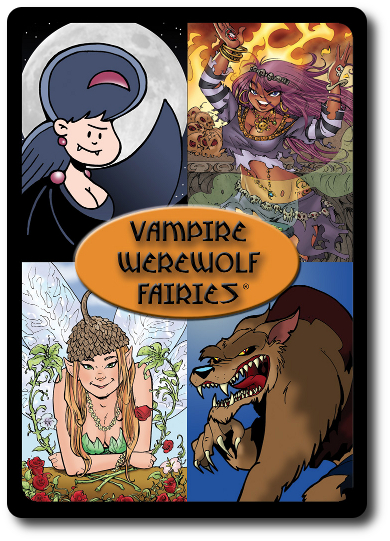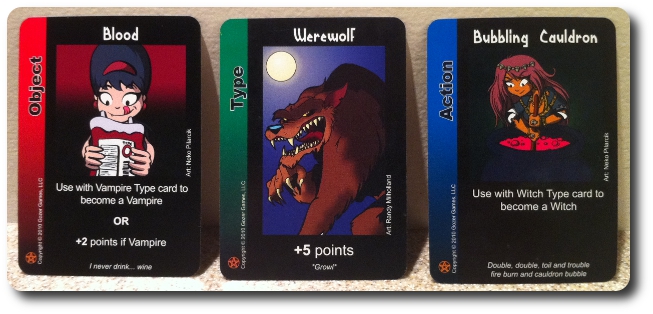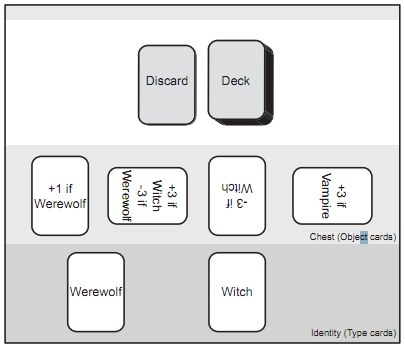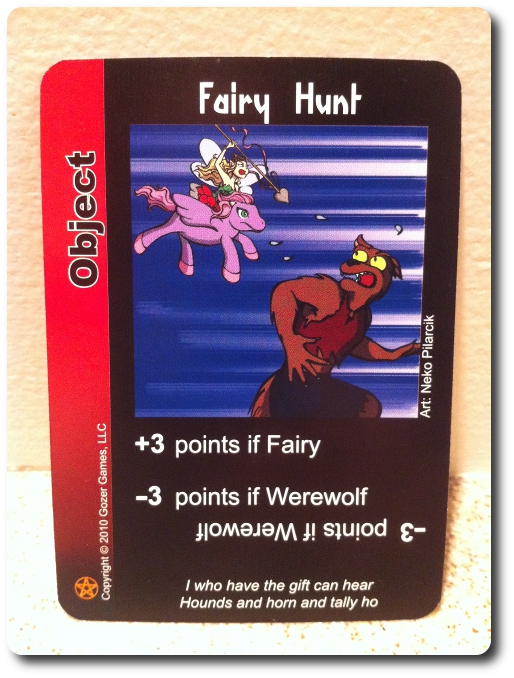
The Basics:
- For ages 7 and up (publisher suggests 13+)
- For 2 to 6 players
- Variable game length (on average about 25 minutes)
Geek Skills:
- Active Listening & Communication
- Counting & Math
- Logical & Critical Decision Making
- Reading
- Hand/Resource Management
Learning Curve:
- Child – Moderate
- Adult – Easy
Theme & Narrative:
- Vampires vs. Werewolves vs. Fairies vs. Witches (OH, MY!)
Endorsements:
- Gamer Geek approved!
- Parent Geek approved!
- Child Geek approved!
Overview
Following in the footsteps of its predecessor, four NEW and somewhat less loved character types, Vampires, Werewolves, Fairies, and Witches, battle for control! But this is no ordinary battle! Vampires will become Werewolves (wait…is such a thing possible?), Werewolves will become Fairies (as silly as that sounds), and Witches pretty much become whatever they want because you just know there is a spell that allows them to do it. Cheaters…
Vampire Werewolf Fairies is a card game comprised of 108 cards. The total deck is further divided into three specific types. These are Type cards, Action cards, and Object cards. There is also one End Game cards that triggers the, yes you guessed it, endgame. All the cards are made of thick card stock, colorful, and very easy to shuffle, but only if you cut the deck in half. I’ve said it once and I’ll say it again, trying to shuffled 108 cards is a foolish use of ones time and energy. We suggest you separate the deck of cards into half and then shuffle each half. Much, much easier.
Not included in the game but suggested is some sort of recording device to keep the score. This is, for the most part, unnecessary as you will keep track of your points during the game with the cards (see “Scoring and Losing Points” below).
Déjà Vu!
If this review is sounding very familiar to you, there is a reason. Vampire Werewolf Fairies plays exactly like it’s predecessor, Zombie Ninja Pirates. It can be played as a game in itself (using the same rules) or combined with the original game to create an epic Zombie Ninja Pirate Vampire Werewolf Fairy experience that also includes Mad Scientists and Witches.
Since geeks tend to lean towards one character type versus another (although it is beyond me why you would not LOVE zombies), the first part of the review will describe how to play the game right out of the box. Admittedly, this is a copy and paste job. Some would call that lazy. I call it “intelligent use of my time”.
The second part will detail the slight changes in the rules if you choose to combine the two games. If you already know how to play the game and want to just read how to combine the two, skip to “CA-CA-CA-COMBO!” below.
Alright? Alright. Let’s get to it.
Game Set Up
To set up the game, find the End Game card and set aside. Take the remaining deck and shuffle thoroughly. Deal out to each player, face-down, five cards each. The players may look at their hand but should keep it hidden from their opponents at all times.
Separate the deck into thirds. Take the End Game card and shuffle it into one of the three piles. Combine the three piles back into one deck making sure to put the third with the End Game card on the bottom of the deck. Place the deck of cards in the middle of the playing area and within easy reach of all players. There should be room just left or right of the deck for a discard pile, too.
Determine who will be the first player and begin.
But before you play, let’s get to know the cards in your hand a bit better.
The Three Card Types
Throughout the game, the players will be managing their playing area by laying down and discarding cards comprised of three specific types. These are Type cards, Action cards, and Object cards. These card types are described in summary as follows:
- Type Cards (green border): These cards allow the player to take on the characteristic of one of the four character types. These are a Vampire, a Werewolf, a Fairy, or a Witch. A player has the possibility of being one or all four of the characters depicted on the character cards during the game, but can never be more than one of each type. For example, a player could be a Vampire Witch, but could not be a Vampire-Vampire-Witch.
- Action Cards (blue border): These cards provide the player to take the action specified on the card. These actions will allow the player to alter the game in their favor and mess with their opponents. Actions cards can be exceedingly powerful and a real game changer but are limited. A player can only play one per turn and must always discard them after use.
- Object Cards (red border): These cards can either be played by the player for points or discarded to complete a specific action. Object cards are not Action cards and do not count towards the player’s limit of one Action card per turn. Object cards can also reduce a player’s points if the player should loose or gain a Type card.

Example of the three types of cards in the game
Of course, there is a reason for these three card types and that reason is to score points!
Scoring and Losing Points
Throughout the game, a player’s points will shift. Played Object cards are used to provide any player a quick overview of how many points a player has at any particular time. This is done by the way the Object cards are displayed in front of a player.
- Card is Upright: The Object card adds points
- Card is Upside Down: The object card reduces points
- Card is Sideways: The Object card provides no points at this time (neutral)
Using this method, a player can quickly shift the cards in front of them to react to the game and quickly determine their overall standing when comparing their points to their opponents.
Note that whenever an Object card cancels out another Object card of the same value, +3 and -3 for example, the two cards are turned sideways.
That’s the basics! Let’s play the game already!
Playing the Game Already
A player completes the following (if able) on their turn in the order given.
- Player must play one Action or one Object card from their hand with the appropriate Type card if possible.
- Player may use 1 Object card from the table in front of them.
- Player may discard any 2 cards from their hand to the discard pile.
- Player draws back up to a total of 5 cards in their hand from the draw pile.

Example of a player's playing area during a game
The first play is to pick either an Action or Object card to use. Action cards can be used when they are played on the owning player or on any opponent as indicated on the Action card. Once used, the Action card is placed in the discard pile, face-up. Object cards, if played instead of an Action card, can be used immediately with their effect and then discarded to the discard pile, face-up. Otherwise, the Object cards are played on the owning player or on any opponent. A player need not be the correct character type (Vampire, Werewolf, Fairy, or Witch) in order to play the Object card and any player can have more than one of the same Object card in front of them at any time. Immediately adjust the Object cards to represent their points in front of the player by rotating it upright, upside down, or sideways.
The second play, which is optional, allows the player to use an Object card already in play or from their hand. In this way, the player is essentially getting a second action. The player can use an Object card in their hand for its effect and discard it to the discard pile, face-up, or select any Object card in front of them. This is a great way to get ride of Object cards that are costing the player points.
The third play, which is also optional, allows the player to discards up to 2 cards from their hand. These cards are placed in the discard pile, face-up.
The fourth, final, and required play is for the player to draw their hand back up to 5 cards.
If at anytime the player is unable to play an Action or Object card on their first play of their turn, or if they choose not to, they discard all their cards in their hand to the discard pile and draw 5 new cards. This ends their turn.
Endgame
Play continues as described above until one of the players draws the End Game card from the draw pile. When drawn, the card is shown to all players and set aside. The player who drew the End Game card now draws back up to 5 cards (if possible) and takes their turn. All other players are given just one more turn, too. All players should attempt to play as many of their cards as possible as this is the final round of play.
Once the last player has completed their turn, the game ends and the points are counted. The player with the most points wins!
CA-CA-CA-COMBO!
You can combine Vampire Werewolf Fairies with Zombie Ninja Pirates to create an epic game that fits 2 to 10 players. That’s a lot of geek! Note that the back of the cards in this game are exactly the same as Zombie Ninja Pirates. In fact, the back of the cards say “Zombie Ninja Pirates”, which I’m sure caused many a geek to scratch their head and ponder. This is not a misprint and was intended to make the merging of both games seamless.
If you combine the two games, it is very easy to separate them again if there is need. Vampire Werewolf Fairies has a small symbol of a Neopagan pentagram located on the lower left corner on the front of the card. Zombie Ninja Pirates does not. Simply look for this symbol to separate the two games.
When you combine the two games, the rules of play are pretty much the same except for the few but very important following exceptions.
First off, you only need one End Game card. Remove the second End Game card if you combine the two games and set it aside. It will not be used for the duration of the game and must be temporary discarded, feeling left out and lonely. Try not to make eye contact with it or you’ll feel guilty and your day will be ruined. Shuffle the lucky End Game card you picked as you would normally.
Remove the Reset card from Zombie Ninja Pirates and place it with the discarded End Game card to keep it company. Or, don’t. It’s optional and suggested, but will not break the game if left in the deck. It will make the game longer. Reset is an Action card and allows the player to reshuffle the discard pile back into the deck.
Instead of 5 cards, each player starts with 7 cards and always draws back up to a maximum of 7 cards at the end of their turn.
All “Boat” cards let you become a Pirate, a Ninja, or (for reasons not at all clear) a Witch. Strange…I thought Witches were afraid of water.
All “Bite” cards let you become a Zombie, a Vampire, or a Werewolf. The action of the stealing a card works for a Zombie or a Vampire. OK, now that does make sense! You know what happens when you get bit by a Pirate? You get gummed. See what I did there?
All “Cure” cards and “Witch’s Brew” cards are worth points for Mad Scientists and Witches.
Using “Cure” and “Witch’s Brew” cards removes Zombie or Vampire (of player’s choice and only one or the other) types from another player. Let’s see….if you cure a Zombie I suppose it just reverts back to a motionless corpse and a cured Vampire just goes back to being a moody teenager, minus the fangs.
All “Internal Conflict” cards can be used on any of the opposite pairs of Type cards. To help you remember this rule, associate the two different Types together based on their intrinsic nature to start a fight with a specific character type. For example, Pirates will go out of their way to irritate Ninjas. The opposite pairs are as follows:
- Vampires & Werewolves
- Witches & Fairies
- Pirates & Ninjas
- Zombies & Mad Scientists
To learn more about the game and read the rules, visit the game’s official web site.
Prediction
None needed. This is going to be as big a hit as Zombie Ninja Pirates was. It is, after all, the same game. In fact, I’m going to skip playing the game alone and combine it to form the “mega game”.
‘Nuff said.
Final Word
First off, there is very little difference in regards to play between Zombie Ninja Pirates and Vampire Werewolf Fairies. This is not a bad thing but should be clear. I don’t want any of you rushing out to buy this game thinking you are going to get something different. But while the rules of the game are the same, the play “felt” anything but. According to my 7-year-old, this was because he was envisioning different character types. Instead of a pirate attacking a ninja, he was imagining a vampire and a werewolf going all Street Fighter on each other. I should also note, that like the original game, Vampire Werewolf Fairies was a lot of fun.
As a combined game, it is more of the same but also trickier. Trickier in the sense that there are more cards to handle and more points to be earned and lost. The game is not anymore difficult, however, and should not be a problem for players already familiar with the game. I do suggest that you do not combine the game right from the start for two reasons. First, a card game with over 200 cards is downright intimidating. Second, learning how four character types operate is easier than learning how 8 character types operate. Once you have players with a few games under their belt, they will have no problem playing both games at once.
All the same geek humor and entertaining flavor text at the bottom of the cards made it to this game. Of special note, I just want to say how thrilled I was to see references to the movie Teen Wolf and the television program Night Court. This made me smile and then frown as I immediately felt my age when I had to explain to my 7-year-old what a teen wolf was and why Night Court had nothing to do with medieval times. My all-time favorite card is the Fairy attacking the Werewolf on a My Little War Pony.

"TO BATTLE, MOONBEAM DREAMS, MY NOBLE STEED!"
Gamer Geeks, this game gets my approval for you game elitists, but only as a light filler or quick group game before you jump into a game with more depth. This game was meant to be entertaining, fast, and not at all taken seriously. That being said, the game does require the competitive player to think about their cards, their timing, and their strategy. The tactics necessary to win will shift as the game continues and new Type cards come into play. The variable game length also makes for some nail-biting towards the end of a playing session as all the player just know the game is drawing to a close. Randomness and luck do play a sometimes significant role in how you will play, but also provides for some great surprises and fun moments in the game. Give it a try the next time you are looking for a lightweight filler or are looking for something to replace your overplayed game of Munchkin. Combining the two games will increase the game length but does not add a lot more to think about, strategy wise. A few new tactics become available, but nothing that I found to be overly unique.
Parent Geeks, this is a fun and casual card game that is easily played with a mixed group of skills and ages, but knowing how to read is a must. Once you meet this requirement, the rest of the game will come pretty easy to the players. This game is also very accessible to your non-gamer friends. It’ll play like a “gamer’s” game but without the heavy requirements and commitments on the player. This makes for a fun experience for everyone and an opportunity to open the gaming hobby to new players. And with the game length being fairly short (even shorter with 5 to 6 players), you can enjoy several games in a single hour. However, if you combine the card games, expect a much longer time at the gaming table.
Child Geeks, you must be able to read before you even attempt to tackle this game. In fact, I’m going to state that reading is not only an absolute must but really the only requirement. The cards tell you what you can do with them making it easy to know what cards to play for the desired effect on the game. There is a level of complexity, however, that you will have to overcome to be a competitive player. Make sure you always attempt to play Object cards that benefit you the most when it comes to the final score and you’ll do great! If you combine the two games, you get a chance to be just about every character type there is! Won’t your parents be proud!
Vampire Werewolf Fairies is as fun as Zombie Ninja Pirates and is just as tongue-and-check as ever. Do not take the game seriously because it most certainly isn’t taking itself seriously. It is meant to be a lightweight “filler” for those gamer elitists who want a quick game to get their minds going or to slowly cool down after a 3 hour game marathon. For the family, the game is great as it isn’t overly demanding and can be taught fairly quickly, even to those friends and relatives who think that “dice” were invented for Yahtzee. Last, but certainly never least, the little geeks can play the game fairly quickly and be just as competitive as the adults at the gaming table. Combining the two games together ensures there is something for everyone without demanding much more from all the players. Fun and light, Vampire Werewolf Fairies is a hit in my house. Give it a try and see if it is the game for you!
This game was given to Father Geek as a review copy. Father Geek was not paid, bribed, wined, dined, or threatened in vain hopes of influencing this review. Such is the statuesque and legendary integrity of Father Geek.




Pingback: Father Geek » Zerpang! Game Review
Pingback: Vampire Werewolf Fairies Guest Review